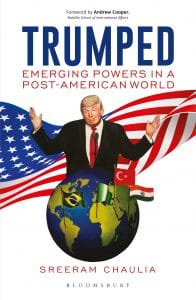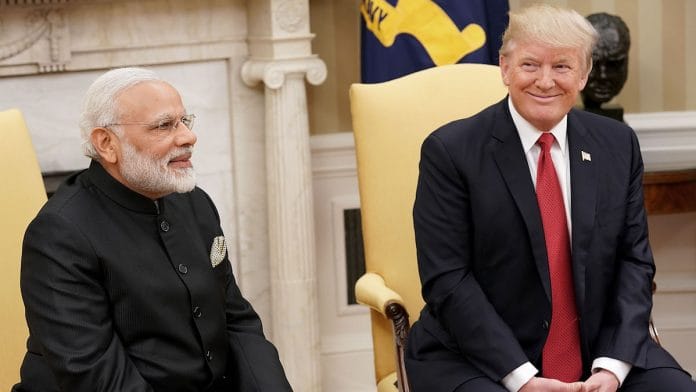India is, of course, not China. As a far less industrialised country where large-scale manufacturing has not yet taken off, India should not have been much of a bother for Trump. Objectively, it is not a principal offender in his hit list of countries amassing gigantic trade surpluses from the US and allegedly fleecing it. India’s trade surplus with the US, just shy of $25 billion as of 2018, was minor compared to China’s nearly $350 billion, or even Japan’s $69 billion, Germany’s $65 billion and Mexico’s $63 billion. And yet, trade hawks in the Trump administration went on an offensive against India and slapped steel and aluminium tariffs worth $240 million, followed by a withdrawal of non-reciprocal Generalised System of Preferences trade benefits worth $5.6 billion in early 2019 that had hitherto accrued to India as special treatment due to developing countries under the World Trade Organization (WTO) rules. The Trump administration also filed a suit against India at the WTO in March 2018 for export subsidies, the first such complaint since 2013. Trump’s hawkish trade representative Robert Lighthizer castigated India’s trade policies as instruments ‘to sell their goods more cheaply to the detriment of American workers and manufacturers’.
These were not minor hostilities. The US has been India’s largest trading partner with the two-way flow in goods and services totalling more than $120 billion annually by 2018. Trade makes up 40 per cent of India’s GDP and Trump’s protectionist threats and policies spread considerable worry in New Delhi that the US president is out to spike India’s economic boom, reduce outflows of American foreign direct investment (FDI) into India, and pose hurdles to Modi’s signature Make in India manufacturing initiative. Modi’s bid to transform India into a manufacturing power depends on the free flow of capital from the US and other advanced economies as well as the openness of global markets— the very conditions Trump is hell-bent to destroy. The contradiction between Make in India and Make America Great Again is unmissable.
The other problem Trump has set up for India is his uncompromising opposition to the movement of skilled Indian personnel to the US in the software services sector. Trump and the Republican-led Congress cracked down hard on the previously relatively easy route for Indian information technology workers into the US under the H1B visa scheme. More stringent conditions, scrutiny, high rejection rates, deportations and barriers to US citizenship for Indian IT professionals have spread fear of a fall in services trade between India and the US. Silicon Valley giants, which depend on relatively cheaper Indian techies on short-term visas in the US, petitioned and lobbied the Trump administration not to mix up the phenomenon of illegal immigration of low-skilled Latinos via the border with Mexico and the hiring of talented software workers from across the globe to boost US corporate bottom lines.
Also read: Why US-China trade war truce will not end protectionist impulse
But Trump has been impervious to pleas. His populist conviction that local American jobs are being displaced by unscrupulous Indians who are gaming the US immigration system is one more threat to the symbiotic link between the Indian and American economies, which had been built up over two decades. To decipher Trump’s ‘Buy American, Hire American’ animus against outsourcing of services to India, his rant against back offices for American companies manned by Indian professionals during the 2016 presidential race is a classic.
‘So I called up, under the guise I’m checking on my card, I said, ‘Where are you from?’, Trump said and then he copied the response from the call center in a fake Indian accent. ‘We are from India,’ Trump impersonated the response. ‘Oh great, that’s wonderful,’ he said as he pretended to hang up the phone. ‘India is great place. I am not upset with other leaders. I am upset with our leaders for being so stupid,’ he said. ‘You can’t allow policies that allows China, Mexico, Japan, Vietnam, India. You can’t allow policies that allows business to be ripped out of the United States like candy from a baby. The manufacturing jobs are being stolen. Our jobs are being taken. We are losing at every front. There is nothing good. Our country does not win anymore. The jobs are being stripped. Factories are closing. We are not going to let this happen anymore.’
If the liberal internationalist establishment, backed by corporate America, perceives America’s partnership with India as a win-win, Trump and his populists look at it as a zero-sum game where America is getting a raw deal.
Facing headwinds in economic relations from Trump’s aggressive and uncompromising economic nationalism, Modi’s government delayed retaliatory tariffs and countervailing measures until June 2019 in the hope of softening Trump’s anger. New Delhi attempted to juxtapose India with China and reasoned that the former poses ‘no such thing as a security threat to the US’. The Make in India programme is far more modest than the Made in China 2025 hi-tech industrial policy under which China aspires to surpass the US in strategic fields like semiconductors, artificial intelligence and aircraft manufacturing through massive subsidies from the Chinese government. Unlike China, which is breathing down America’s neck in cutting-edge sectors, Indian industrialisation is still relatively immature and not top-of-the-line. Some Indian strategists speculated that a full-blown US-China trade war would benefit India, as friction between Washington and Beijing might redouble New Delhi’s value in Washington’s eyes as a less confrontational actor.
 This excerpt from Trumped: Emerging Powers in a Post-American World by Sreeram Chaulia has been published with permission from Bloomsbury India.
This excerpt from Trumped: Emerging Powers in a Post-American World by Sreeram Chaulia has been published with permission from Bloomsbury India.






